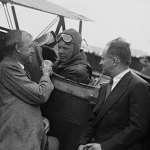 Technology
Technology  Technology
Technology  Humans
Humans 10 Everyday Human Behaviors That Are Actually Survival Instincts
 Animals
Animals 10 Animals That Humiliated and Harmed Historical Leaders
 History
History 10 Most Influential Protests in Modern History
 Creepy
Creepy 10 More Representations of Death from Myth, Legend, and Folktale
 Technology
Technology 10 Scientific Breakthroughs of 2025 That’ll Change Everything
 Our World
Our World 10 Ways Icelandic Culture Makes Other Countries Look Boring
 Misconceptions
Misconceptions 10 Common Misconceptions About the Victorian Era
 Mysteries
Mysteries 10 Strange Unexplained Mysteries of 2025
 Miscellaneous
Miscellaneous 10 of History’s Most Bell-Ringing Finishing Moves
 Technology
Technology Top 10 Everyday Tech Buzzwords That Hide a Darker Past
 Humans
Humans 10 Everyday Human Behaviors That Are Actually Survival Instincts
 Animals
Animals 10 Animals That Humiliated and Harmed Historical Leaders
Who's Behind Listverse?

Jamie Frater
Head Editor
Jamie founded Listverse due to an insatiable desire to share fascinating, obscure, and bizarre facts. He has been a guest speaker on numerous national radio and television stations and is a five time published author.
More About Us History
History 10 Most Influential Protests in Modern History
 Creepy
Creepy 10 More Representations of Death from Myth, Legend, and Folktale
 Technology
Technology 10 Scientific Breakthroughs of 2025 That’ll Change Everything
 Our World
Our World 10 Ways Icelandic Culture Makes Other Countries Look Boring
 Misconceptions
Misconceptions 10 Common Misconceptions About the Victorian Era
 Mysteries
Mysteries 10 Strange Unexplained Mysteries of 2025
 Miscellaneous
Miscellaneous 10 of History’s Most Bell-Ringing Finishing Moves
10 Musicians Who Became Famous After Death
Musicians understand that they may never achieve stardom, but there is no way of knowing if they will turn into legends posthumously. Some musicians work hard at their craft and spend decades trying to succeed. They write and record multiple songs and albums, earn record deals, and travel the world, playing their music anywhere that will have them.
Unfortunately, their talents are still usually hidden from most people. However, some musicians leave their mark behind after they are gone. Here are ten musicians who became more famous after death.
Related: 10 Musicians Who Changed How Everyone Plays Their Instruments
10 Jim Croce
Jim Croce was an American folk singer who released five albums between 1966 and 1973, but most of his success came after his death in 1973. His first album was a self-issued solo album, but in 1968, he and his wife released a studio album together. The couple traveled across America performing at coffeehouses and college concerts but soon felt disconnected from the music. They moved to the countryside of Pennsylvania, where he worked driving trucks and construction, but he continued to write songs in his free time.
In 1970, Croce linked up with another musician and started recording new music. ABC Records signed him and released his first solo album You Don’t Mess Around with Jim, and it saw instant success as it quickly became a Top 20 album. The title track was a Top 10 pop hit, and a second song from the album also broke into the Top 20. His second album, Life and Times, quickly followed. It featured the hit “Bad, Bad Leroy Brown,” which hit the #1 spot on American charts.
In September 1973, Croce and five others died in a plane crash in Natchitoches, Louisiana. His third album, I Got a Name, was released posthumously in December 1973. The album featured the hits “Workin’ at the Car Wash Blues,” “I Got a Name,” and “I’ll Have to Say I Love You in a Song.” The album peaked at the #2 spot on the charts, while two hit songs broke into the Top 10 singles charts. His music gained more interest after his death, and the song “Time in a Bottle” from an earlier album landed at the #1 spot on the charts.[1]
9 Jeff Buckley
Jeff Buckley had a promising career in music, but it was cut short after his surprising death. Buckley grew up in a family dedicated to music, so naturally, he chased the same career. He wowed members of the music industry while performing at a tribute concert for his late father, who was a successful musician. Sony signed him and released his first album, Grace. After touring for three years, Sony wanted him to start working on his second album. Buckley felt a lot of pressure and was terrified of compiling the album.
After much thought and consideration, Buckley went to Memphis to record his second album, tentatively called My Sweetheart the Drunk. After failing to find the location where his band would rehearse, he drove down to a channel of the Mississippi River with a friend. He began to wade in the water, fully clothed, as a boat approached. The friend turned away to remove their boombox from the ensuing waves, but Buckley was gone when he turned back. A few days later, his body was located. Sony ended up releasing his second album, and interest in his first album finally started to grow. His rendition of Leonard Cohen’s “Hallelujah” performed well on several charts.[2]
8 Otis Redding
Otis Redding was raised in Macon, Georgia, where he was deeply influenced to become a soul musician. He was a part of a local Georgia band when the group traveled to Memphis to record. Redding sang two of his own songs at the end of the session, which ultimately attracted a manager and record label executive. He started making hit music in 1965 with his gritty vocals and then teamed up with Booker T. and the MG’s, his backing band.
Redding and his band were just entering a new stage of popularity when tragedy struck. Redding and most of the band were killed when their plane crashed in a lake in Wisconsin. After his death, his song “(Sittin’ on) The Dock of the Bay” shot to the top of the charts. It was his only number-one hit, but several other songs also made the charts, such as “The Happy Song (Dum Dum),” “Amen,” and “Papa’s Got a Brand New Bag.” He was later inducted into the Rock and Roll Hall of Fame, received the Grammy Award for lifetime achievement, and is seen as a master of his genre.[3]
7 Ian Curtis
Ian Curtis was the lead singer and lyricist for the British band Joy Division. The band was starting to see success when his personal demons led him to commit suicide. Curtis was an epileptic, suffering from depression, battling a broken marriage, and struggling with substance abuse. He took his life just two days before the band was set to depart for their potentially life-changing tour in the United States.
The only album the band released while Curtis was still alive was Unknown Pleasures. However, their second album, Closer, was released two months after his death. The remaining band members decided to retire the band’s name and continue as New Order. They were able to find success and popularity, but without Curtis and their first two albums, the band wouldn’t have been able to succeed.[4]
6 Johann Sebastian Bach
Johann Sebastian Bach is a famous German composer of the Baroque era. He came from a family of successful musicians, but his popularity wouldn’t rise until after his death. He was viewed as too old-fashioned during his life, and much of his musical career was tied to the church. His focus on religious compositions pushed him from being mainstream, and his works fell into obscurity after his death.
It wasn’t until 1829 that Bach’s music saw new life after Felix Mendelssohn’s performance of “St. Matthew Passion” in Berlin. His music was reintroduced to a completely different generation, and it was learned that it was still culturally relevant. Bach’s music has been used by musicians throughout the centuries in various genres, such as pop and jazz. His compositions may not have gained popularity during his lifetime, but he is now considered one of the greatest minds in music.[5]
5 Bradley Nowell
Bradley Nowell was the lead singer and co-founder of the ska punk band Sublime. Their first album, 40oz. to Freedom, and the second album, Robbin’ the Hood, barely saw success. However, their self-titled third album was a major label debut album. The much-anticipated album was only two months away from release when Nowell was found dead in a motel room after a long night of partying. He died from a heroin overdose.
The third album ended up being a huge hit and gained the band worldwide fame. The single “What I Got” reached the #1 spot on the Modern Rock chart, and several other singles from the album saw success, such as “Santeria,” Wrong Way,” and “Doin’ Time.” The album was certified as 5x platinum, and the band had finally reached the success they were searching for.[6]
4 Eva Cassidy
Eva Cassidy released the album Songbird, selling over five million copies worldwide. The album reached 6x platinum status in England and was certified platinum in America, but she never knew of her success. In 1996, Cassidy died at the age of 33 from cancer. She had melanoma removed in 1993 but failed to follow up with her doctor as it aggressively spread to her lungs and bones.
The singer didn’t receive much attention during her short life and mostly played for small crowds in the Washington, D.C., area, but the British newspaper the Guardian described her as “one of the greatest voices of her generation.”[7]
3 Robert Johnson
Robert Johnson is considered one of the greatest blues musician performers of all time, but that recognition only came after his death. Johnson traveled around playing his music wherever he could, but he initially struggled as a guitarist. Legend says he gained his musical talents by selling his soul to the devil. He disappeared in Clarksdale, Mississippi, for a few weeks as a good harmonica player, but he was a master of the guitar when he made a return.
In 1938, Johnson died at the young age of 27 as a suspected victim of a deliberate poisoning. He wrote and recorded almost 30 songs, including hits such as “Sweet Home Chicago” and “I Believe I’ll Dust My Broom.” His music remained relatively unknown until the 1960s when Columbia Records released King of the Delta Blues Singers, a compilation album by Johnson. That album was ranked #374 on Rolling Stone’s 500 Greatest Albums of All Time. Several of his songs have been recorded by artists such as Eric Clapton and Muddy Waters.[8]
2 Nick Drake
The classic British folk singer and songwriter Nick Drake went mostly unnoticed during his first three albums, Five Leaves Left (1969), Bryter Layter (1971), and Pink Moon (1972). He was working on a fourth album when life began to get too hard. He had a nervous breakdown in 1972 that led to five weeks in the hospital for severe depression. He was living in poverty, borrowing his mom’s car, and wasn’t tending to his hygiene anymore. In 1974, Drake overdosed on an antidepressant at his parents’ home.
In the 1980s, several musicians, including REM’s Kate Bush and The Cure’s Robert Smith, named Drake an important influence. Then, in 1999, Volkswagen released a commercial that featured Drake’s music, and interest in his music started to grow. Sales of his album Pink Moon increased almost by 500% for the first ten weeks of 2000, and the New York Times reported that in 2001, sales of his albums had jumped from around 6,000 copies a year to almost 75,000.[9]
1 Sid Vicious
The punk rock band the Sex Pistols was formed in 1975, and Sid Vicious was chosen to replace the band’s original bassist in 1977. His bad attitude and messy appearance made him the ideal candidate to join the group. The Sex Pistols didn’t care about creating hit albums, or much of anything else for that matter. Punk music fans loved their “don’t-care” attitude, and they still managed to sell a lot of records.
The band ultimately fell apart in 1978 after escalating drug use and feuds with Nancy Spungen, Vicious’s partner. He and Spungen moved to New York City, where they lived at the Chelsea Hotel. The couple spent most of their time experimenting with drugs, and in October of 1978, Spungen was found dead on their bathroom floor. She was stabbed with a knife that was given to her as a gift from Vicious, and he wasn’t sure what happened after he was found in the hallway high out of his mind.
He was charged with second-degree murder but was released on bail. He found himself back in prison, though, after a fight in New York City. He was released in February 1979, and he was found dead the following morning of a drug overdose. His sudden and shocking death only helped cement his legacy as a rock icon. The Sex Pistols became revolutionary as time passed, and Vicious became celebrated in books, songs, and movies.[10]








